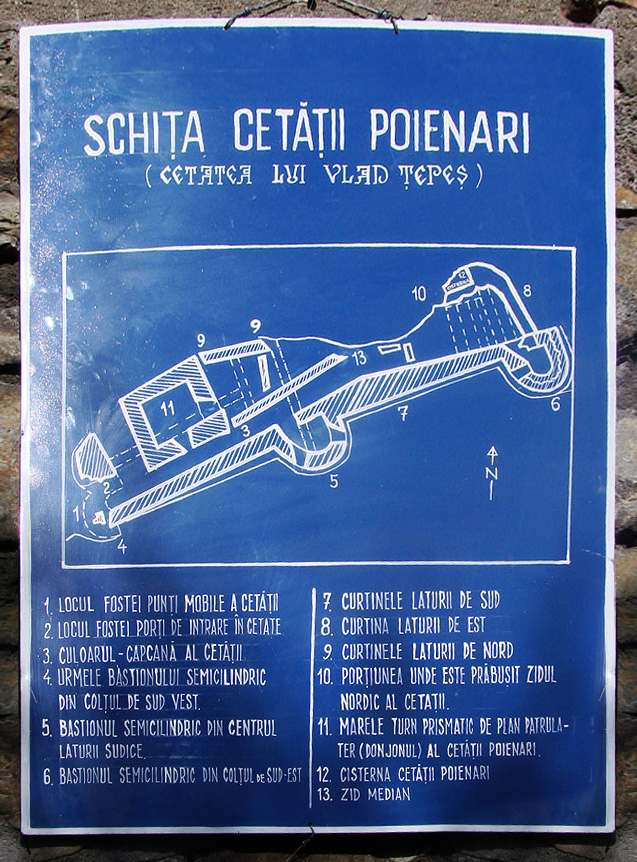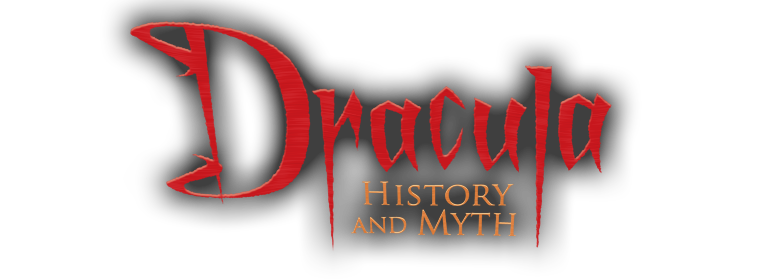A map of Castle Poenari

This metal sign is near the castle, but I somehow didn’t notice it during my visit. A lady who’d contacted me with some questions before her own trip to Poenari took this photo and shared it with me when she got back. I did my best to translate the Romanian with Google Translate and Wikipedia, but there are definitely some things that could use some clarification; please feel free to send me corrections if you’re fluent in Romanian!

Here’s my translation, with notes at the bottom:
(Vlad Țepeș’ Castle)
1. Drawbridge to the former castle1
2. Former gateway into the castle
3. Corridor – the castle trap2
4. Traces of a semi-cylindrical bastion, southwest corner3
5. Semi-cylindrical bastion in the central southern side4
6. Semi-cylindrical bastion in the southeast corner
7. [Curtinele – wall?], south side5
8. [Curtin], east side
9. [Curtinele], north side
10. Wave is a collapsed portion of the northern castle wall6
11. Prismatic quadrilateral watershed (dungeon) of Castle Poienari7
12. Cistern
13. Median wall8
I’ve written up some notes that point out some parts of this map in my photos from my own visit to the castle.
1 In the fourth photo on this page I’m facing the castle from the far side of the bridge, which would be off to the left of the map.
2 First photo on this page.
3 In photos two and three on this page I’m outside the castle facing up to this part.
4 In the second photo on this page I’m in the southeast bastion facing the south-central one.
5 I haven’t been able to find any satisfactory translation for “curtinele” or “curtin,” but it seems like it’s probably just the castle walls.
6 I think “wave” is referring to sort of the edge of the castle terrain here, where there used to be a wall. It’s probably one of the pieces of the castle that was destroyed in an earthquake in the 19th century.
7 The tower/dungeon(/watershed) is featured in photos three, four, and five of this page. I’m not sure what they mean by “prismatic” here, and I’m not sure if this area was both a watershed and a dungeon, or possibly both?
8 In the third photo on this page, I’m standing near point 13 and facing the tower, point 11.


Hi Manning,
here’s a quick translation of a native speaker:
1. The place of the former drawbridge of the castle
2. the place of the former gate of the castle
3 the trap corridor of the castle
4 the traces of the semi-cyllindrical bastion of the south-west corner
5 the semi-cyllindrical baston at the center of the southern side
6 the semi-cyllindrical baston at the SE corner
7 the south side curtains
8 east side curtain
9 north side curtain
10 the part where the northern side wall has collapsed
11 the big quadrilateral-secion plan tower (the donjon) of the Poienari castle
12 the cistern of the Poienari castle
13 middle-side wall
Thanks so much, Daniel!!
a note for the meaning of “Donjon”: it is the equivalent of the french “donjon”, meaning the keep of the castle
“prismatic” means “having a prism-like form”
The prismatic watershed donjon means that the roofs of the castle keep were designed in angles to gather rainfall into the cistern. It was quite ingenious and necessary for such a castle position to have a sustainable water system and shows that a master engineer was involved
A ‘curtain wall’ is the outer wall of a fortification, like curtains drawn around the inner buildings.